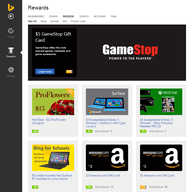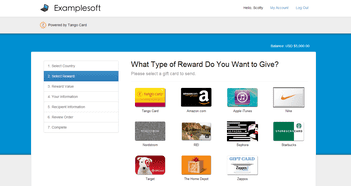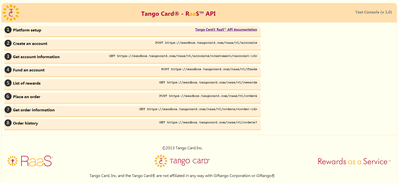Gamification
Let's Talk Tango Card: Behind the Software with CEO David Leeds

The gift card industry has exploded in growth. Cards have expanded from a single de-emphasized rack to a full-on aisle in the grocery store. Coffee shops, fitness facilities, sales teams, software developers and clothing boutiques alike are adopting rewards programs to improve retention and increase motivation of both employees and customers. In today’s business world, to keep a customer or an employee is much cheaper than to acquire one, thus spawning the era of the customer, of the employer and of incentive.
The gift card industry is transitioning to a new kind of gift card — one that is digital and redeemable in a variety of ways. We chatted with the man on the forefront of this revolution, Tango Card CEO David Leeds, about digital gift cards’ influence to the workforce, not only in providing incentive but also in the cards’ ability to give to nonprofits, shop locally or do a combination of both.
Can you tell me how the idea your company was conceived and evolved into what Tango Card is today?
I started Tango Card in 2010 when I was doing research on electronic payments. My last company was a telecommunications infrastructure company and I was struggling a bit in terms of what to do next. Much of my experience and network was in the telecom arena, but I was also interested in doing something outside of telecom. In any event, as I was researching payments over wireless networks, I stumbled upon this huge, quickly-growing industry that piqued my interest — rewards and incentives.
Companies in the US spend about $50 billion a year on rewards and recognition. But more interesting was the way that it was done. There were large, incumbent providers of rewards and recognition, using physical products that are distributed through large catalogs. Even more surprising was that the primary solution in this industry was the “do-it-youself” solution – over half of companies were DIYers. Rewards systems have been the same for years if not decades. These approaches didn’t match what companies, employees and customers needed. They required a much faster, more engaging process.
That mismatch between the company’s needs and the company’s practices led to Tango Card. Rather than being an incentive, a gift card or a catalog company, Tango Card became a software company to solve the problems customers needed solved. We call our approach “Rewards as a Service.” It means when companies want to have recognition for their employees or a loyalty program for their customers, they have a specific business goal in mind. Then we at Tango Card help achieve that goal and make that experience awesome.
We are a purely enterprise-focused company, and we now have two core products that meet our customer needs. We have a comprehensive content strategy and today more of the rewards we delivery are digitally delivered gift cards. We launched commercially in late 2010 and we have now entered our fourth full year of operation.
Are you able to walk me through how someone would receive a Tango Card?
Here are three examples:
 |
| Through Tango Card’s API, Bing Rewards directly integrates with Tango Card for a seamless user experience. |
One way to engage with a Tango Card would be if your search the web. Bing has an engagement and loyalty program called Bing Rewards. The business problem that Microsoft is trying to solve is to get individuals to search on Bing and continue searching on Bing. With Bing Rewards, you earn credits as you engage and can then exchange your credits for products like digitally delivered gift cards, nonprofit contributions and unique offers. This is directly integrated inside of Bing, so you could request a Starbucks card, an Amazon card or a Tango Card within the site … and never leave their site.
Another way to receive a card would be if you work at a company. There are all kinds of cool, lightweight employee engagement programs like Kudos, YouEarnedIt and Salesforce Work.com. Inside of these platforms, managers and peers are able to recognize each other. Whether it’s a consistent contribution to the corporate culture or an accomplishment above and beyond expectations, the platform can give badges or specific rewards with real value. These platforms offer digital gift cards delivered via the Rewards as a Service (RaaS) API. These companies use this API to seamlessly integrate rewards into their platforms. This helps drive engagement with the core platform and makes the experience simple and awesome for the “giver” and the “recipient.”
Another way that you might get a Tango Card is if your company offers a modern wellness program. Your company might provide incentives for you to bike or walk to work. Many companies are putting rewards and recognition to use to incent behaviors rather than outcomes for a whole range of things.
How would somebody be able to use a Tango Card in a store without, say, cards or cash?
When you receive a Starbucks card, an Amazon card or a Tango Card via email, there’s one of two ways to use the digitally-delivered gift card. Half the time people print them out and bring them to a Nordstrom, Target or wherever the card’s for. Then at the point of sale they’ll present the emailed gift card to be scanned or typed in.
You can also add a gift card to a mobile app. Almost everyone has these now. Then you present the screen on the mobile app at the cash register. Or, if you have been to any Starbucks, you’ll see these readers at the point of sale. The merchant will scan your phone and directly charge the gift card. Starbucks is the best known for doing this and they’ve done a brilliant job. While the other retailers are playing catch up, it’s becoming easier to use the digitally delivered gift cards. For people that want to print them out, they can. But for people that want to put them on their phone, the range of apps that are available to do that is pretty large now.
You said that you focus mostly on enterprise, but you also have a small business edition. What are the key differences between the two?
The key distinction is enterprise versus consumer. The consumer gift card industry is huge. It’s probably twice as big as the enterprise gift card industry. The gift card is the number one product that’s given as a gift. It grows by several billion dollars every year. Giving someone a gift card for a birthday, Mother’s Day or for Christmas serves extremely well today. You can’t walk into a grocery store and not see the huge gift card racks. That business has been around for a long time, but there’s probably thirty startups that have tried to find ways to deliver gift cards digitally. So our key delineation is this: we don’t participate in that industry at all. It’s not our focus.
We do have one product for the large enterprise and another product that’s for smaller companies. Our large enterprise product is our API. We want to make it easy for modern platform companies, where it’s relevant, to integrate rewards in what they do. The API is sophisticated and the functionality is robust with a range of functionality that can support a customer the size of Microsoft or Salesforce.
Our small business edition is actually something we’re literally launching today. We call it Rewards Genius. Of course I’m biased – but I think it’s very cool. But what’s cool about it is that it is the first web-based platform that allows any company of any size to instantly set up a recognition program for their employees.
“We don’t charge fulfillment fees. We don’t send an army of consultants to set the program up. We don’t have a heavy physical catalog of goods. …You literally only pay for the rewards that you’re sending.
We live in a world today obviously where good employees have more choices than ever. The best employees are the ones that are constantly being approached by others. The key issue on any HR manager’s mind is retention. We created Rewards Genius as a way to help companies invest directly in their culture and create a robust way for companies to engage their employees by recognizing them in an easy, cost-effective way.
With Rewards Genius, you upload your company logo and company color scheme and then do some light configuration by choosing, for example, what your core values are. You can upload white lists so you can decide who can send rewards and who can receive rewards. Then you fund your account to whatever level you want. It could be $1,000. It could be $100,000. After that, it’s ready to start sending rewards throughout your company.
 |
| Rewards Genius allows small businesses to create and brand their own digital rewards program. |
Setting up the program doesn’t cost anything. We don’t charge fulfillment fees. We don’t send an army of consultants to set the program up. We don’t have a heavy physical catalog of goods. It allows companies to set these programs up and are easy to administer. It has all kinds of reporting capabilities and you literally only pay for the rewards that you’re sending. We’ve already got customers — some large and some small — and it’s been a huge success.
How does the Tango Card API work to measure rewards and integrate with other systems?
If you have a credit card, you are most likely already involved in a loyalty program. You get a statement in the mail and it says “Hey, you’ve got however-many points. Go to this website, login and spend your points.” There’s statistics widely reported that as soon as you have to login to a separate system to take advantage of the rewards, you immediately lose 35 percent of the audience. These programs never get used simply because it takes too many extra steps.
Now it’s 2014. Here we are. People expect more. One of our core beliefs is rewards need to be integrated into platforms that people are already using. For instance, you’re already earning your credits at Bing; you see your credits in the top right corner and redeem credits directly on the Bing platform. It’s fully integrated inside the application you use. I believe in integrating rewards. But that means that the UI lives on the “platform” partner side and the platform defines the user experience. They also set up the points mechanisms and some other capabilities. This ultimately means the need a strong technology-oriented company that allows them to do all of this creative stuff in an integrated way. Our API serves rewards for a range of audiences. That’s the role that our API plays. It allows large companies to create an application with built-in rewards as opposed to the old-school approach. We’ve also learned a lot in the last 4 years and we offer a fair amount of learnings, insights, and good practices to all of the partners we work with. It’s fun working with companies to create great solutions and define how the enormous world of enterprise rewards is going to look in the next decade.
 |
| Tango Card’s Rewards-as-a-Service API removes boundaries from rewards by allowing users to redeem directly on an application. |
Tango Card has also partnered with nonprofits. How does your company provide incentive to donate?
Gift cards are a remarkable product. 95 percent of the gift card experience today is positive. People get to choose how they spend the value, getting something fun that they wouldn’t have otherwise gotten. It becomes a great experience for the card owner.
One of the two negative things about gift cards is — “Oh no. I got a gift card to a store that I don’t go to.” Then you don’t use it. You can’t exchange a gift card. There’s probably a hundred websites where you can sell it, but you’d lose 20 to 30 percent of the value plus, more importantly, the time it takes to bother.
And the second complaint: it ends up being about expiration dates and fees.
When I started the company, the reason we created our own Tango Card was to have a product that was incredibly flexible. It eliminated those problems. Do you love Amazon? Get an Amazon card. If you love REI, get a REI card. If you want to split your Tango Card across multiple cards, great. And no fees or expiration dates. It’s simply the best gift card product in the market – especially for enterprise reward situations.
“The nonprofit thing has been a big differentiator for us from day one, and we continue to invest in it. I love that part of what we do.
We also have a nonprofit option by partnering with incredible organizations like Habitat for Humanity and the National Park Foundation. Some people can’t accept a gift if it’s from a supplier or a customer, but they can donate that value. The nonprofit option is awesome because maybe someone can’t take a $500 gift from a supplier because it could be considered undue influence. Instead of returning a gift card or putting it in a drawer somewhere, they can instead donate that value in a productive way.
Some can just decide they don’t need another gift, or maybe even choose to split a gift between Starbucks and Habitat for Humanity. The nonprofit thing has been a big differentiator for us from day one, and we continue to invest in it. I love that part of what we do.
You have the option to get gift cards from big places like Starbucks and Amazon, but you also have a local or neighborhood feature?
This is probably one of the most exciting things for us in 2014. We launched Neighborhood in 2013. Gift cards are a fun experience, especially if you keep a gift card on your mobile device. You can be out on a weekend and realize — wow — I forgot that I got $100 from my employer for staying late last week. Neighborhood allows you to pull up your Tango Card app and, instead of clicking on a national retailer, you click on Neighborhood and choose from 30,000 nationwide locations. You can decide the night of to have your meal or movie covered. Of course, redeemable retails are more heavily concentrated in bigger cities like Seattle, New York or San Francisco, but you could still redeem a Tango Card through Neighborhood in a small town.
The whole neighborhood product offering or the whole neighborhood content is something that we’ll make available across all of our platforms: both the web and mobile throughout the course of 2014. We’ll also be adding a lot more merchants. Later in 2014, you’ll have double the retail options. It is an exciting thing for us and Neighborhood will make the Tango Card that much more appealing.
Where do you see incentive systems going in the future and where is Tango Card headed?
In incentive programs today, about three percent of these are delivered digitally. Like many other industries that are moving from non-digital to digital, this aspect of the industry has grown fast. From 2012 to 2013, growth for digital rewards and recognition systems grew ten-fold. That pace is going to continue.
On the employee side, you’ll move away from monolithic approaches where the HR team has to research a solution for a long time, then implement and manage it. Today there’s only a few lightweight, easy-to-implement employee engagement platforms. They don’t have too many bells and whistles and are used by either an entire companies or individual teams. In 2014 and beyond, you’re going to see rewards built into a modern business application as opposed to a stand-alone application that requires separate logins or several websites. Digital rewards and software integration is going to remove any inconveniencing boundaries.
Every day there are probably 50 new apps that hit the app stores with a reward component built in. It could be a secret shopper app or a gaming applications with incentives for leaderboard toppers, or even a wellness applications that helps people change behavior. The migration to digital is going to be way faster than anybody expected, and how rewards and recognition are being used is amazing — and will only continue to grow.






